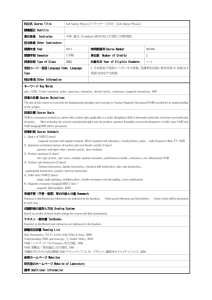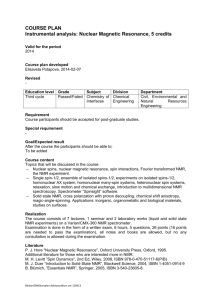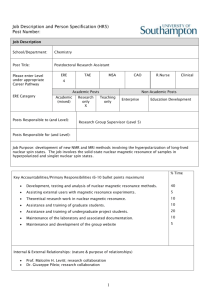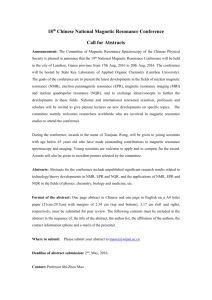W,4-29-09
advertisement
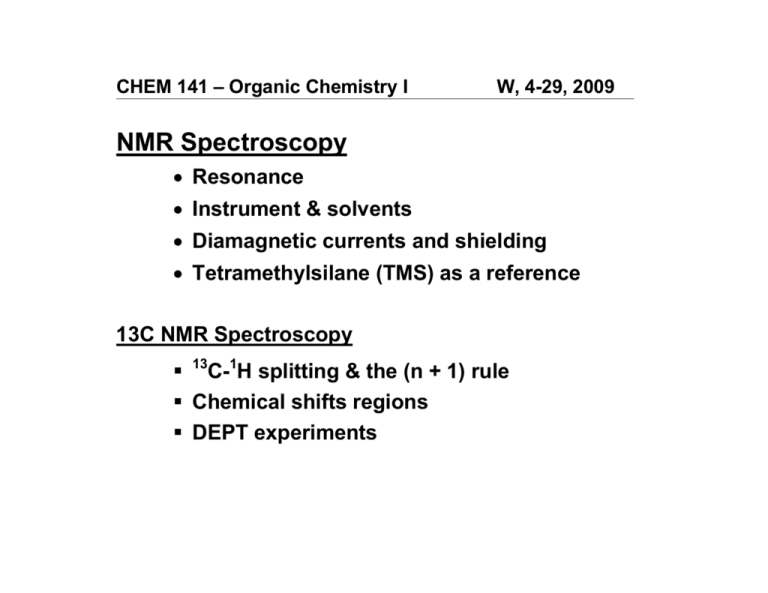
CHEM 141 – Organic Chemistry I W, 4-29, 2009 NMR Spectroscopy • Resonance • Instrument & solvents • Diamagnetic currents and shielding • Tetramethylsilane (TMS) as a reference 13C NMR Spectroscopy 13C-1H splitting & the (n + 1) rule Chemical shifts regions DEPT experiments Nuclear Spin in B0 • the energy difference between allowed spin states increases linearly with applied field strength • values shown here are for 1H nuclei Nuclear Magnetic Resonance • when nuclei with a spin quantum number of 1/2 are placed in an applied field, a small majority of nuclear spins are aligned with the applied field in the lower energy state • the nucleus begins to precess and traces out a coneshaped surface, in much the same way a spinning top or gyroscope traces out a cone-shaped surface as it precesses in the earth’s gravitational field • we express the rate of precession as a frequency in hertz Nuclear Magnetic Resonance • Figure 13.3 the origin of nuclear magnetic “resonance Nuclear Magnetic Resonance If the precessing nucleus is irradiated with electromagnetic radiation of the same frequency as the rate of precession, • the two frequencies couple, • energy is absorbed, and • the nuclear spin is flipped from spin state +1/2 (with the applied field) to -1/2 (against the applied field) Nuclear Magnetic Resonance • Figure 13.3 the origin of nuclear magnetic “resonance Nuclear Magnetic Resonance Resonance: in NMR spectroscopy, resonance is the absorption of electromagnetic radiation by a precessing nucleus and the resulting “flip” of its nuclear spin from a lower energy state to a higher energy state The instrument used to detect this coupling of precession frequency and electromagnetic radiation records it as a signal • signal: a recording in an NMR spectrum of a nuclear magnetic resonance NMR Spectrometer NMR Spectrometer Essentials of an NMR spectrometer are a powerful magnet, a radio-frequency generator, and a radio-frequency detector The sample is dissolved in a solvent, most commonly CDCl3 or D2O, and placed in a sample tube which is then suspended in the magnetic field and set spinning Using a Fourier transform NMR (FT-NMR) spectrometer, a spectrum can be recorded in about 2 seconds 0.2 0.4 0.6 0.8 1.0 1.2 1.4 1.6 1.8 2.0 2.2 22.4 .4 2 .6 2.8 3.0 3 .2 3 .4 Nuclear Magnetic Resonance • if we were dealing with 1H nuclei isolated from all other atoms and electrons, any combination of applied field and radiation that produces a signal for one 1H would produce a signal for all 1H. The same is true of 13C nuclei • but hydrogens in organic molecules are not isolated from all other atoms; they are surrounded by electrons, which are caused to circulate by the presence of the applied field • the circulation of electrons around a nucleus in an applied field is called diamagnetic current and the nuclear shielding resulting from it is called diamagnetic shielding Nuclear Magnetic Resonance • the difference in resonance frequencies among the various hydrogen nuclei within a molecule due to shielding/deshielding is generally very small • the difference in resonance frequencies for hydrogens in CH3Cl compared to CH3F under an applied field of 7.05T is only 360 Hz, which is 1.2 parts per million (ppm) compared with the irradiating frequency 360 Hz 300 x 106 Hz = 1.2 106 = 1.2 p pm Nuclear Magnetic Resonance • signals are measured relative to the signal of the reference compound tetramethylsilane (TMS) CH3 CH3 Si CH3 CH3 Tetrameth yls ilane (TMS) • for a 1H-NMR spectrum, signals are reported by their shift from the 12 H signal in TMS • for a 13C-NMR spectrum, signals are reported by their shift from the 4 C signal in TMS • Chemical shift (δ): the shift in ppm of an NMR signal from the signal of TMS 13C-NMR Each Spectroscopy nonequivalent 13C gives a different signal • a 13C signal is split by the 1H bonded to it according to the (n + 1) rule • coupling constants of 100-250 Hz are common, which means that there is often significant overlap between signals, and splitting patterns can be very difficult to determine most common mode of operation of a 13CNMR spectrometer is a hydrogen-decoupled mode The 13C-NMR Spectroscopy In a hydrogen-decoupled mode, a sample is irradiated with two different radio frequencies • one to excite all 13C nuclei • a second broad spectrum of frequencies to cause all hydrogens in the molecule to undergo rapid transitions between their nuclear spin states the time scale of a 13C-NMR spectrum, each hydrogen is in an average or effectively constant nuclear spin state, with the result that 1H-13C spin-spin interactions are not observed; they are decoupled On Chemical Shift - 13C-NMR Typ e of Carbon Chemical S hift (δ) RCH3 RCH2 R R3 CH 10-40 15-55 20-60 RCH2 I RCH2 Br 0-40 25-65 RCH2 Cl 35-80 R3 COH 40-80 R3 COR 40-80 65-85 RC CR R2 C=CR2 100-150 Type of Carb on C R Chemical Sh ift (δ) 110-160 O RCOR 160 - 180 O RCNR2 165 - 180 O RCCOH 165 - 185 O O RCH, RCR 180 - 215 Chemical Shift - 13C-NMR The DEPT Method In the hydrogen-decoupled mode, information on spin-spin coupling between 13C and hydrogens bonded to it is lost The DEPT method is an instrumental mode that provides a way to acquire this information • Distortionless Enhancement by Polarization Transfer (DEPT): an NMR technique for distinguishing among 13C signals for CH , CH , CH, and quaternary carbons 3 2 The DEPT Method The DEPT methods uses a complex series of pulses in both the 1H and 13C ranges, with the result that CH3, CH2, and CH signals exhibit different phases; • signals for CH3 and CH carbons are recorded as positive signals • signals for CH2 carbons are recorded as negative signals • quaternary carbons give no signal in the DEPT method Isopentyl acetate • 13C-NMR: (a) proton decoupled and (b) DEPT 13 C-NMR • Much lower sensitivity than 1H NMR (13C abundance 1.1%) • Don’t see 13C-13C couplings (most 13C are next to a 12C) • Since 13C-1H couplings are large & overlap with other signals, we usually run “protondecoupled spectra. • # of signals (lines) gives # of different carbons • Chemical shifts suggest functional groups present • Range of chemical shifts (δ) much wider than for H’s (0 to approx. 200 ppm) • Integrations not reliable • DEPT experiments performed to determine # of attached protons




